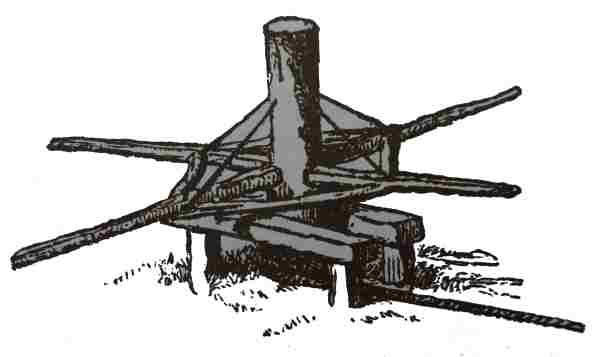1859: The Thames, Mr & Mrs Hall
* The old locks were much less navigable than those that have been constructed within the last
 thirty or forty years. In old times it was no uncommon
case to be compelled to drag the barge through one of
them, for which purpose a winch was used. These winches
are still found occasionally on the banks of the river, and
we thought it worth while to picture one of them. It is
of rude construction, with four hands, the rope rolling
round the centre as the boat progressed. We believe they
are now entirely disused, and are only found in the immediate vicinage of deserted locks.
They certainly add to the picturesque of the scenery, especially as they are usually
found in quiet and retired nooks on the river's banks.
thirty or forty years. In old times it was no uncommon
case to be compelled to drag the barge through one of
them, for which purpose a winch was used. These winches
are still found occasionally on the banks of the river, and
we thought it worth while to picture one of them. It is
of rude construction, with four hands, the rope rolling
round the centre as the boat progressed. We believe they
are now entirely disused, and are only found in the immediate vicinage of deserted locks.
They certainly add to the picturesque of the scenery, especially as they are usually
found in quiet and retired nooks on the river's banks.
Right bank a few yards above the weir (CAREFUL!) - access by boat only
1898: A dispute between the Conservancy and the
landowner of the Right bank just above the weir.
There was an old winch used for winching barges up the flash lock which
was next to it. It was said to be the
last surviving on the river. The
Conservancy claimed the winch and the land on which it stood and the two plots
of land forming the old flash lock. The
Conservancy had to admit defeat and requested that the antique relic should be
preserved. Fred Thacker wrote -
The relic is covered with a climbing rose, under whose disguise the old hardswearing and much enduring bargemen would be puzzled to recognise it.
1910: Fred Thacker has this picture:

Old winch at Hurley, 1910
This Right bank above Hurley Weir is owned by SAS UK who own the Wittington Estate -
The Wittington Estate includes the riverside strip below the cliffs -
bought by Kearley to annoy his next-door neighbour, Robert Hudson of Sunlight Soap fame,
who had acquired the Danesfield estate in the 1890s. This effectively denied Hudson
access to the river - a situation that still exists today. Kearley and Hudson had
both previously lived in Medmenham, a mile to the west of Wittington, and this
is where their rivalry started. Hudson was responsible for building the current Danesfield
House, which is the second time the house has been rebuilt.
The Thames at SAS UK also features a flash-lock capstan, said to be the only one left in
the whole of England. Restored in 1999, it was originally used to pull river barges
up the flash-lock prior (and for some time after) the pound lock was built in 1780.
Kearley restored and repaired it from time to time from estate oak.
SAS UK now maintains this historic site.
2006: The winch rotated at the touch of a finger -

Old winch at Hurley, 2006
[ But of course it's not a drum winch with a big handle that the name winch had led me to imagine.
In naval terms, the difference between a capstan or windlass
and a winch is that a capstan or windlass has a vertical axis of rotation,
while a winch has a horizontal axis of rotation.
I see that the sign board near it describes it as a "capstan wheel" - but that is a modern interpretion. The old texts all call it a winch.
However this "winch" has a rotating vertical shaft (presumably well sunk down into the ground)
with six horizontal beams. The line might either
have been wound up on the vertical shaft as it was rotated by pushing round the
beam, or maybe there were just several turns on the shaft and the line then led
off to be laid out ready for use? Either
way the thought of pulling a heavily laden barge up that weir by this method
makes me devoutly thankful for pound locks with keepers and hydraulics.
See WHITCHURCH LOCK for the use of such a winch. ]